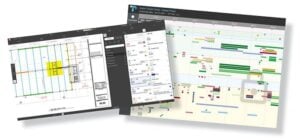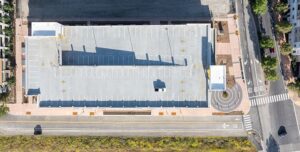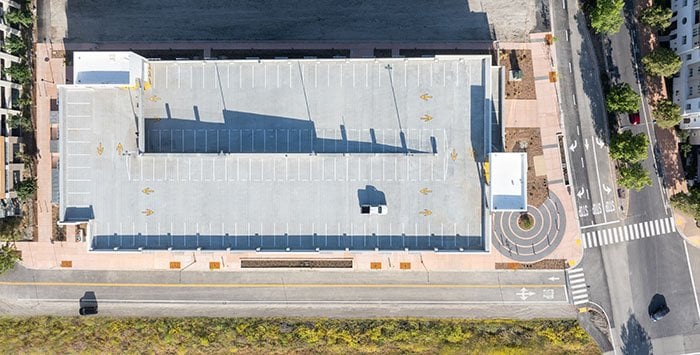To optimize the process of delivering parking buildings, project teams must begin by conducting thorough planning and developing a comprehensive understanding of project needs
By Fernando Sanchez
Parking buildings are vital to the functionality and success of development projects, regardless of use type. Whether they are part of a healthcare facility, university or college campus, commercial center, office building, or mixed-use space, parking buildings are essential components of new developments and expansions.
Speed to market is a top priority for owners and developers when deciding on the viability of a given project. For projects in which parking is a key component, identifying strategies that affect cost and schedule certainty are crucial in achieving timely project delivery. Despite their importance, details regarding parking buildings are often oversimplified or deferred at the planning stages. This oversight frequently leads to cost overruns and schedule delays when decisions subsequently must be made in a hurry or with unclear criteria. There is a misconception that parking buildings are simple and inexpensive when they actually require careful, precise planning.
Across all development types, several crucial factors help to optimize the development of parking buildings. These factors address various aspects of a project, including program and jurisdictional code requirements, design and permitting processes, and construction methodologies. To ensure cost and schedule certainty during the design and construction of parking buildings, project participants must conduct thorough planning and develop a comprehensive understanding of project needs. In both cases, the earlier these tasks are completed, the better.
Considering key factors

IMAGES COURTESY OF MCCARTHY BUILDING COMPANIES, INC.
Primary considerations take the form of client, functionality, and aesthetic needs. Client needs, or program requirements, are paramount. These include defining “the box” by identifying required parking spaces and their dimensions, the number of levels allowed and the number required, pedestrian destination and vehicle circulation, and other functional elements like regional sustainability and electrification advances — for example, in California, the California Green Building Standards Code, commonly known as CalGreen, establishes minimum requirements pertaining to electric vehicle (EV) charging stations.
Although functionality is always the primary design consideration, aesthetics should not be overlooked. The visual appeal of a parking building can affect the overall perception of the development, making it an important design element. Depending on the level of aesthetic considerations and the amount of façade material required to cover the concrete structure elevations as part of the development, this system could significantly affect a project's cost and construction schedule.
Schedule, budget, and costs — always critical factors —are interdependent with the design process. Initiating and setting the appropriate design expectations earlier in the process has the greatest effect on successfully delivering a project. Effective budgeting and cost management strategies that involve the owner, designers, and general contractors are necessary to expedite development of the project — from design to permitting to construction — and remain on schedule. Unaligned expectations in earlier phases of a project often lead to increased costs and delays in subsequent phases of the project or diminish a team’s ability to resolve issues.
Deciding on a delivery method

IMAGES COURTESY OF MCCARTHY BUILDING COMPANIES, INC.
The choice of contractual delivery method also affects a project's delivery timeline. The traditional design-bid-build method focuses on identifying and selecting program and aesthetic requirements, sometimes extending the resolution of design issues through the permitting processes to eliminate code issues. Under this approach, parking designers help owners make appropriate decisions for their parking program and produce sets of drawings that a contractor can price and formulate a construction schedule. Some helpful activities that contractors may perform with this method include value engineering and constructability reviews to help projects achieve their projected budgets, construction schedules, or both.
These separate activities — design, permit, bid, value engineer, and build — increase the time frames required for each and extend overall project timelines, which typically translates to higher costs for any development.
In contrast, the design-build method focuses more on integrating construction means and methods alongside the design phases with activities that include material selection and effective systems integration. This approach enables the contractor to become a key team member and find a balance between the aims of designers and construction partners with the goal of achieving the owner’s requirements.
Design integrators are included on the team to facilitate communication between various partners, helping the owner to balance design decisions within the context of cost and scheduling. Timely input on material costs, means and methods affecting detailing, and early involvement of trade partners ensures that the final design aligns closely with the conceptual development and the owner's expectations.
Other delivery methods define the different levels of input from the owner, designer, or contractor and define the project management approach that can affect how quickly decisions are made.
Building the dream team
Selecting a team of subject matter experts — architects, engineers, contractors, and others with specific expertise in parking buildings — is the most important decision when it comes to optimizing the parking building development process. Their in-depth knowledge of specific design applications, materials, and codes that often affect costs and schedules enable them to guide the owner in identifying suitable programs, flagging code issues, and deciding on construction detailing specific to a building type. Having access to this deep knowledge can significantly reduce the time spent on decision-making and implementation.
The speed at which decisions are made heavily influences the speed at which a project develops and concludes. This principle is evident in the design, permitting, and construction phases. For example, during the design phase, a deep and current knowledge of available parking systems helps determine appropriate budgets and type and complexity of parking technologies (users, access and revenue control systems, EV charging, connectivity to campus/development, and level of aesthetics). In turn, these determinations reduce the time required to explore options, the suitability of a system, and the components needed for functionality.
Knowledge of code interpretations and design issues specific to parking buildings helps reduce the number of cycles a project endures during the permitting review process. In addition, knowledge of construction methodology and early input into the design development phase ensures that decisions are made promptly, potential issues are addressed early, and appropriate budgets established. This is particularly the case for such project aspects as detailing, construction methods, and integration of systems — for example, electrical conduiting, plumbing pipes, light fixtures, storm water discharge points of connection, and the like.
(Design) integrating a parking project
Implementing a “design-integration approach” — as mentioned in the description of the design-build delivery method above — can be particularly advantageous for parking building projects, as it fosters collaboration and efficiency from the onset by promoting a cohesive understanding of project requirements in both design and budget. This understanding stems from design integrators “bridging the gaps” between designers, contractors, and other stakeholders to increase understanding across all parties and reach project milestones quicker.
A design integrator plays a crucial role in translating aspirational language from owners and designers into practical terms, including means and methods, cost, and schedule milestones throughout the design and construction phases. A design integrator’s key contribution is to help identify and bring the needed people and knowledge at the right time to make decisions quicker.
Design integrators, alongside their teams, can use several management tools and techniques to further streamline processes and achieve goals. Two main approaches that greatly affect the performance of a team are Lean and Target Value Delivery (TVD). Implementation of these approaches from the onset of a project improves efficiency by refining how a team develops a design, resolves issues, and advises owners to make decisions based on project goals.
Borrowed from the manufacturing industry, Lean helps increase efficiency by identifying ways a team can continuously improve its processes, either by agreeing how information is exchanged, what level of information is developed and at which phase, and/or who should be involved in developing that information. These types of process improvements ultimately help owners, designers, and contractors make decisions faster.
TVD approaches project development by incrementally increasing the accuracy of design, cost, and schedule through directly involving the appropriate subject matter experts — trade partners, manufacturers, designers, estimators, schedulers, maintenance staff, operators, inspectors, permit reviewers/approvers, and the like —
at the right step in the design development process. This involvement makes budgets and schedules more realistic and reliable.
Lean principles and pull planning — a scheduling technique that starts with an end goal and works backward to identify the steps (phases, milestones, and intermediate activities) needed to get there — define an approach that helps increase budget and schedule certainty by reducing wasteful efforts. A key strategy in these approaches involves aligning participants on a decision-making structure so that all are aware of when and by whom design direction is provided. This approach exposes processes and focuses work on necessary activities by identifying predecessor and successor activities among all project team members. For example, the level of technology appropriate for the parking program is defined before locating and sizing equipment rooms and conduits in support of these technologies.
TVD enables contractors to work in tandem with the design team to estimate costs as plans develop. This method helps align design decisions with cost expectations from the beginning and, through several incorporated processes, enables greater communication about an expected design and anticipated budgets. As the design and construction industries tackle more complex systems in parking building types, greater full-team collaboration is required to meet increased expectations for project delivery.
Several other project-management approaches, tools, and techniques exist — like the Last Planner System from the Lean Construction Institute, the scrum methodology, and the kanban system — beyond the traditional critical-path method exemplified by the standard project management schedules known as Gantt charts. Familiarity with these approaches, tools, and techniques and what each can accomplish will help a team tailor its overall project and design management to the particular needs of a project and owner.
Although the process is the real focus, emerging technologies and tools are also playing a role in optimizing project management in the design and construction industry. For example, platforms like Touchplan and vPlanner for pull planning, Join for estimating value add and target-value delivery, and Revizto for 3D model and design issue risk logs provide greater visibility into project steps. These tools aim to improve the speed and accuracy of decision-making by all project partners and stakeholders by facilitating access to up-to-date information.
Stepping into the future
With more than 275 million vehicles registered in the United States, parking buildings aren’t expected to disappear any time soon. For owners and developers taking on the task of parking building projects, timely and budget-conscious project completion is essential for success. By focusing on effective planning, selecting the right team and delivery method, and utilizing advanced management tools, project teams can achieve greater efficiency and cost certainty.
Looking ahead, the advent of artificial intelligence tools promises to further enhance decision-making speed and data management. However, the emphasis will always remain on teams managing the design and robust processes that leverage the expertise of parking building subject matter experts to ultimately meet and exceed project goals.
Fernando Sanchez is the integrated design director for parking buildings at McCarthy Building Companies, Inc. He can be reached at fsanchez@mccarthy.com.














